Hot milk, vertical cutting and sweet syrups: How to make the perfect sponge cake
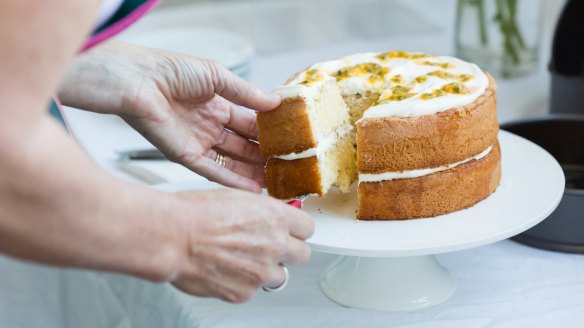
Nothing captures the spirit of home baking more than a classic sponge. Eggs, sugar, self-raising flour, a dash of this and a spoonful of that – and presto – you have an elegant teatime treat to make nanna proud.
Not that there's anything old-fashioned about a good sponge. The public's affection for the lightest and airiest of cakes has barely waned since the days of Queen Victoria. Today, sponges are riding the crest of the "naked cake" wave and rivalling fruit cake as the go-to wedding celebratory confection.
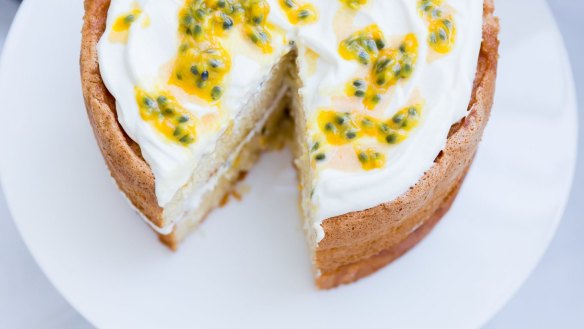
But it's still the pretty home-made variety, fresh from the oven with lashings of jam and cream, that most readily comes to mind. So why aren't they on heavier rotation in the home kitchen?
"Sponges are one of those things a lot of people are scared of and there's a lot of trepidation around," says cooking teacher and author Anneka Manning, of Sydney baking school BakeClub.
"They have a reputation for being tricky – like meringue and pastry. If you don't know how to approach the technique of making a sponge – or nobody has taught you – they can be quite temperamental.
"People approach them often expecting they are going to fail because they don't have the know-how or confidence."
Once you understand a few key cookery basics, however, you'll be able to whip up a sponge without any fuss, Manning says.
"My mum just used to get into the kitchen and do it," she says. "What I learnt from that is if you know a little bit about the 'why' behind the 'how' of anything you bake, it becomes very simple and it becomes really easy to achieve.
"Just to have a few tips and tricks along the way makes a big difference."
Heat your milk
Manning prefers to warm the milk with the butter before adding it to the eggs – her mother used to do it that way, and it helps the ingredients mix together more easily. "The warmth in the milk [helps] it combine really beautifully," she says. "It really helps [avoid] a lot of those flour lumps that can cause a sponge to become heavy or you feel like you have to fold them or mix them a lot to break those lumps up. It helps prevent all of that."
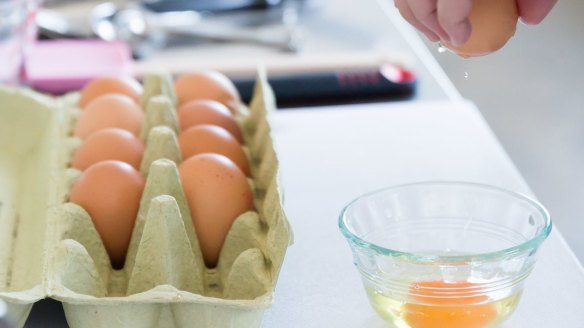
It's crucial your eggs are fresh and at room temperature, Manning says. Why? The fresher the egg, the more acidic they are, and the more tightly knit the protein bonds. The point of whisking eggs is to pull apart those bonds, then reconfigure them into a new bubbly structure. So while an older egg might be easier to break apart, it won't form a very stable foam. Why room temperature, then? If an egg is too cold, it will be too hard to pull apart those bonds. "It's kind of a fine line that you're compromising," Manning says. "[If you] use really fresh eggs at room temperature, you'll get the best of both worlds. You'll get a really stable foam that will hold up to a little bit of whisking once you start adding flour."
Perfect whisking
The aim of whisking is to combine whole eggs and sugar to "ribbon form", Manning says. Take the whisk off your mixer and slowly wave the tip over the top of the mixture in the shape of a figure eight. "If that figure eight is still completely visible by the time you've finished drawing that figure eight then you're ready to add your milk and butter to the mixture." If the figure eight falls away quickly and sinks into the mixture, then you'll need to whisk for another minute before testing again. Alternatively, you can rub some of the egg mix between your fingers – if you feel any undissolved sugar between your fingertips you have more whisking to do.
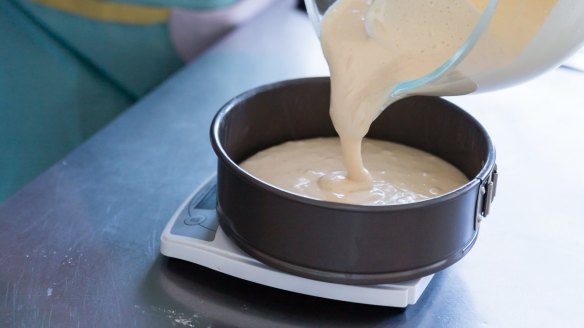
There's nothing worse than cooking a gorgeous sponge, just to ruin it as you prise it out of the pan. Manning suggests using a brand of spring-form pan that allows you put the base on upside down, which makes it ultra-easy to take the base off and means you won't scratch your pan digging the cake out. And go for the non-stick variety if you can because it skips the whole grease-flour-line rigmarole, which - due to the paper on the bottom - can lead to a cake shrinking with sloping sides. For the best crust and finish, just grease the non-stick surface quickly and pour the batter in.
Ready or not
Oven went ding but not sure if your cake is ready? Press the top with your finger lightly and if it springs back a little it's good to go. It will also be starting to pull away from the side of the tins. Sponges can overbake easily so if it isn't quite ready, pop it back in the oven and test it again in a minute or two. You don't need to let the cake stand for too long in a non-stick pan before removing it – just run a knife quickly around the sides if it needs help releasing. Turn it onto a cake rack covered in a tea towel to prevent the top from being marked and then invert it again onto another rack to cool.
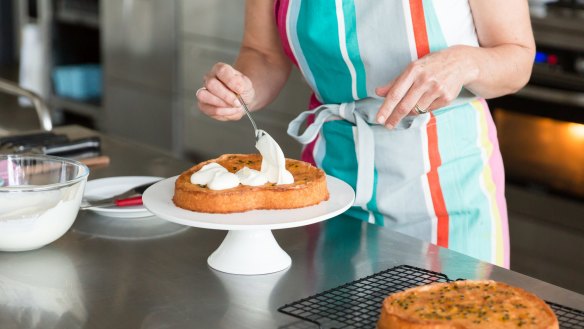
Dressing up
From nut crumbles to rose petals, Nutella to raspberries, sponge cakes can be dressed up any number of ways. One of Manning's favourites is a passionfruit syrup sponge – not only do sponges soak up syrups well, they keep the cake fresher for longer. If you're not keen on passionfruit, try a citrus, cardamom or cinnamon syrup – or any other topping you fancy. When it comes to adding cream between layers of sponge, don't be tempted to pour a whole bowl on, Manning says. She spoons her cream on rather than spreading it, leaving about half a centimetre of bare sponge at the edge. "Once you put the top [sponge] layer on you're going to squash that cream down in the middle and you don't want it all flowing down out the sides."
Cutting the cake
Cutting a sponge might seem straightforward but using a thick knife to chop downwards runs the risk of squashing the cake and squishing all the delicious innards out the side. To avoid such carnage, Manning suggests cutting vertically rather than horizontally. A small serrated knife is best – one about the same height as the cake. Insert the knife into the centre of the cake and cut the cake outwards using a sawing action. Serve, and eat.
Anneka Manning's passionfruit syrup sponge recipe
Preparation time: 25 minutes (+30 minutes cooling)
Baking time: 18-20 minutes
Ingredients
250ml (1 cup) thickened cream
60ml (¼ cup) fresh passionfruit pulp
Sponge layers
Melted butter, to grease
4 fresh eggs, at room temperature
1½ tsp natural vanilla essence or extract
165g (¾ cup) castor sugar
60ml (¼ cup) milk
30g butter, diced
110g (¾ cup) self-raising flour, plus extra to dust
30g (¼ cup) cornflour
Passionfruit syrup
110g (½ cup) caster sugar
125ml (½ cup) water
2 tbsp strained fresh lemon juice
60ml (¼ cup) fresh passionfruit pulp
Method
1. To make the sponge layers, place the oven rack in the oven so that the cake tins will sit in the middle of the oven. Preheat it to 180 Celsius (160 Celsius fan-forced). Brush two 20-centimetre spring-form tins with melted butter to grease.
2. Use an electric mixer with a whisk attachment on medium-high speed to whisk the eggs and vanilla in a medium bowl until frothy. Add the sugar a spoonful at a time, whisking well between each addition, until the mixture is very thick and pale and the sugar has dissolved (this will take about eight minutes). Lift the whisk out of the mixture and slowly draw a figure eight. If the trail stays on the surface long enough for you to finish drawing then the mixture is ready. If not, continue to whisk for a further minute and test again.
3. Meanwhile, heat the milk and butter in a small saucepan over medium heat until the butter melts and mixture is almost simmering. Remove from the heat. Sift the flour and cornflour together over the egg mixture. Immediately pour the hot milk mixture down the side of the bowl and whisk briefly again with the electric mixer on low speed, until the flour mixture is just incorporated (make sure there is no flour caught at the bottom of the bowl and be careful not to overmix).
4. Divide the mixture evenly between the cake tins and gently tap the tins on the bench top three times to settle the mixture. Bake for 18-20 minutes or until the cakes are a pale golden colour, spring back when lightly touched in the centre and start pulling away from the sides of the tins. Remove from the oven and stand for one minute before turning onto a wire rack over a tray, top side up.
5. Meanwhile, to make the passionfruit syrup combine the sugar, water and lemon juice in a small saucepan and stir over medium heat until the sugar dissolves. Bring to a simmer. Remove form heat and stir through the passionfruit pulp.
6. Use a skewer to prick the sponge layers all over. Gradually pour the hot syrup over the warm cake, allowing it to soak in. Set aside to cool completely.
7. When ready to assemble, use an electric mixer with a whisk attachment or a balloon whisk to whisk the cream in a medium mixing bowl until soft peaks form. Place one layer of the sponge on a serving plate or cake stand and spread with half the cream and then drizzle with half the passionfruit pulp. Top with the remaining sponge layer. Spread the remaining cream and drizzle with the remaining passionfruit pulp. Serve in slices.
Serves 8
Try these other sponge toppings:
- Chocolate curls
- Roasted nuts (such as hazelnuts, pistachios and pecans)
- Dried rose petals
- Strawberries
- Raspberries
- Figs
- Rosewater cream
- Vanilla cream
- Berry jam
- Fig jam
- Dulche de leche
- Nutella
- Mini vanilla meringues
- Pistachio, coconut and cardamom crumble
- Cardamom syrup
- Cinnamon syrup
- Citrus syrup
- Candied citrus rind
- Passionfruit icing
- Chocolate glace icing
The best recipes from Australia's leading chefs straight to your inbox.
Sign up